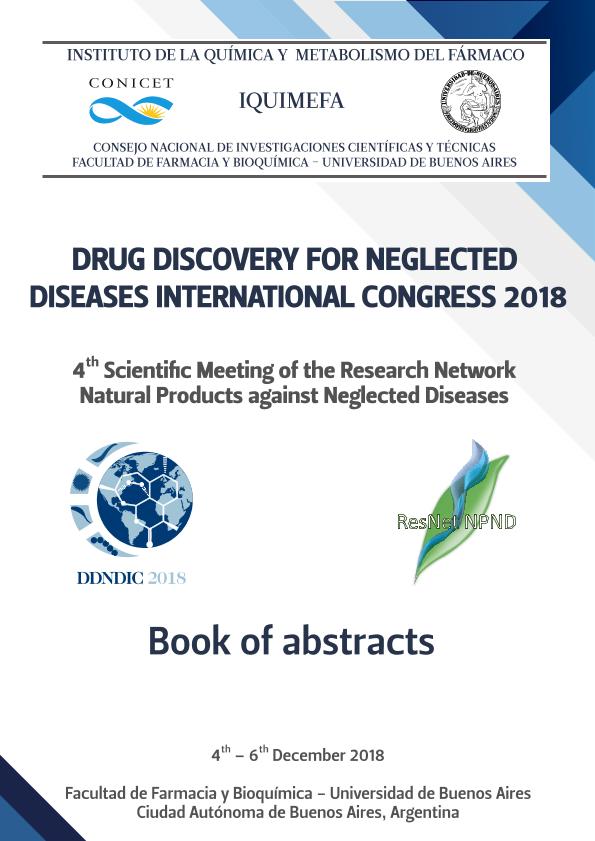Evento
Diisopropylphenyl-imidazole exerts anthelmintic activity through novel molecular mechanisms
Blanco, Maria Gabriela ; Aletto, Facundo Gastón; Masson, Camila; Vela Gurovic, Maria Soledad
; Aletto, Facundo Gastón; Masson, Camila; Vela Gurovic, Maria Soledad ; Silbestri, Gustavo Fabián
; Silbestri, Gustavo Fabián ; Garelli, Andres
; Garelli, Andres ; Rayes, Diego Hernán
; Rayes, Diego Hernán ; de Rosa, Maria Jose
; de Rosa, Maria Jose
 ; Aletto, Facundo Gastón; Masson, Camila; Vela Gurovic, Maria Soledad
; Aletto, Facundo Gastón; Masson, Camila; Vela Gurovic, Maria Soledad ; Silbestri, Gustavo Fabián
; Silbestri, Gustavo Fabián ; Garelli, Andres
; Garelli, Andres ; Rayes, Diego Hernán
; Rayes, Diego Hernán ; de Rosa, Maria Jose
; de Rosa, Maria Jose
Colaboradores:
Sülsen, Valeria Patricia ; Redko, Flavia del Carmen
; Redko, Flavia del Carmen
 ; Redko, Flavia del Carmen
; Redko, Flavia del Carmen
Tipo del evento:
Congreso
Nombre del evento:
4th Scientific Meeting of the Research Network Natural Products against Neglected Diseases
Fecha del evento:
04/12/2018
Institución Organizadora:
Universidad de Buenos Aires;
Título del Libro:
Drug Discovery for Neglected Diseases International Congress 2018: book of abstracts
Título de la revista:
Drug Discovery For Neglected Diseases International Congress 2018
Editorial:
Universidad de Buenos Aires. Facultad de Farmacia y Bioquímica. Instituto de Química y Metabolismo del Fármaco
ISBN:
978-987-47034-0-8
Idioma:
Inglés
Clasificación temática:
Resumen
Nematode parasites cause substantial morbidity to billions of people and considerable losses in livestock and food crops. The repertoire of effective anthelmintic compounds for treating these parasitosis is very limited, as drug development has been delayed for decades [1,2]. Moreover, resistance has become a global concern in livestock parasites, and is an emerging issue for human helminthiasis. Parasitic resistance has been reported for all classes of anthelmintics [3,4,5,6]. Therefore, anthelmintics with novel mechanism of action are urgently needed. In this context, the use of non-parasitic nematodes, such as C. elegans, has emerged as a model of parasitic roundworms to test new possible anthelmintics [7,8]. C. elegans is a free-living nematode that shares phylum-specific properties with parasitic roundworms and has been extensively used as an inexpensive, safe and powerful model in biomedical research [9,10]. Therefore, we here screened the nematicidal potential of novel imidazolium and imidazole derivatives, using C. elegans as an established model system. One of these derivatives, diisopropylphenyl-imidazole (DII), is lethal to C. elegans at both mature and immature stages. This lethal effect appears to be specific as DII is harmless to bacteria, Drosophila melanogaster and human cell cultures. Our analysis of DII action on C. elegans mutant strains determined that, in the adult stage, null mutants of unc-29 are completely resistant to the drug. We did this by analyzing the survival of several null mutant worms in presence of the drug diluted in Nematode growth media after 4, 8, 24, 48 and 72 hours of exposure. Muscle expression of this gene completely restores DII sensitivity. UNC-29 has been largely reported as an essential constituent of the levamisole-sensitive muscle nicotinic receptor (L-AChR) [11]. Nevertheless, null mutants in unc-63 and lev-8 (essential and non-essential subunits of L-AChRs, respectively) are as sensitive to DII as the wild-type strain. Therefore, our results suggest that DII effects on adult nematodes rely on a previously unidentified UNC-29-containing muscle AChR, different from the classical L-AChR. Strikingly, DII targets appear to be different between larvae and adults, as unc-29 null mutant larvae are sensitive to the drug. The existence of more than one target could delay resistance development. Its lethality on C. elegans, its harmlessness in non-nematode species and its novel and dual mechanism of action converts DII in a promising candidate compound for anthelmintic therapy.
Archivos asociados
Licencia
Identificadores
Colecciones
Eventos(INIBIBB)
Eventos de INST.DE INVEST.BIOQUIMICAS BAHIA BLANCA (I)
Eventos de INST.DE INVEST.BIOQUIMICAS BAHIA BLANCA (I)
Citación
Diisopropylphenyl-imidazole exerts anthelmintic activity through novel molecular mechanisms; 4th Scientific Meeting of the Research Network Natural Products against Neglected Diseases; Buenos Aires; Argentina; 2018; 210-211
Compartir



